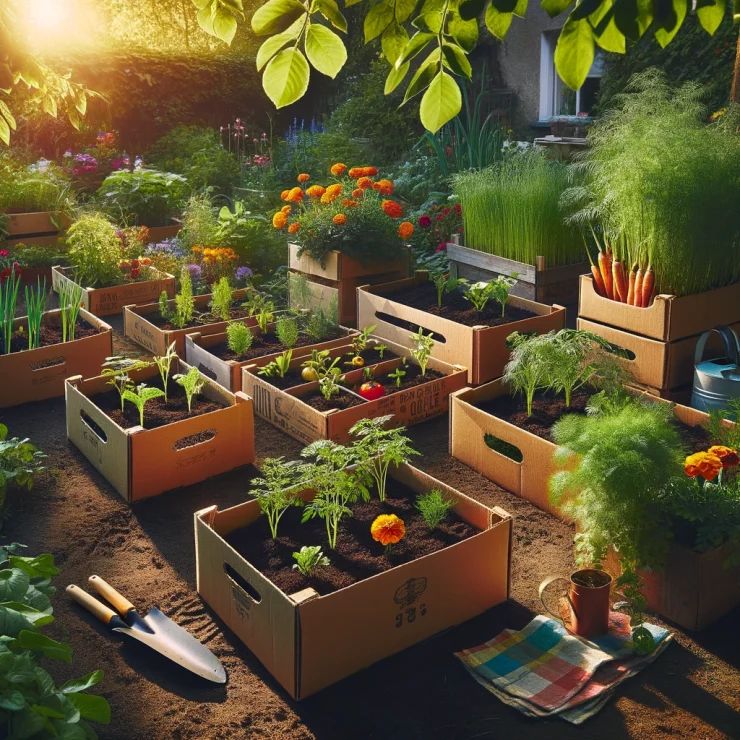In the world of gardening, innovation is key. As enthusiasts strive to cultivate lush greenery and vibrant blooms, they often seek methods that are both effective and efficient. One such technique that has been gaining traction among gardeners is the use of cardboard boxes as a planting medium. Surprisingly simple yet remarkably effective, this approach offers a no-dig solution to traditional gardening woes.
Gone are the days of back-breaking labor, digging up soil and tilling the land. With the advent of cardboard box gardening, enthusiasts can now enjoy the benefits of gardening without the hassle of traditional methods. But how exactly does it work?
The Basics of Cardboard Box Gardening
The concept behind cardboard box gardening is delightfully straightforward. Instead of tilling the soil and creating traditional garden beds, gardeners simply lay down flattened cardboard boxes directly onto the ground. These boxes act as a barrier, smothering any existing vegetation underneath while also providing a base for planting.
Once the cardboard boxes are in place, gardeners can add layers of soil, compost, and mulch directly on top. This creates a fertile planting bed without disturbing the underlying soil structure—a process commonly referred to as “no-dig gardening.” The result is a thriving garden with minimal effort and maximum efficiency.
Advantages of Cardboard Box Gardening
The benefits of cardboard box gardening are manifold, making it an attractive option for both novice and experienced gardeners alike.
Weed Suppression: By smothering existing vegetation, cardboard boxes effectively suppress weed growth, reducing the need for tedious weeding sessions.
Soil Conservation: Traditional gardening methods often lead to soil erosion and compaction. With cardboard box gardening, the underlying soil is left undisturbed, promoting healthy soil structure and conservation.
Moisture Retention: The layers of cardboard, soil, and mulch help retain moisture within the planting bed, reducing the need for frequent watering—a boon for water-conscious gardeners.
Nutrient Enrichment: As the cardboard decomposes over time, it adds organic matter to the soil, enriching it with essential nutrients for plant growth.
Versatility: Cardboard box gardening is highly versatile and can be adapted to various spaces, including urban gardens, raised beds, and even container gardening.
Cost-Effective: Cardboard boxes are readily available and often free, making this method not only effective but also budget-friendly.
Getting Started with Cardboard Box Gardening
Ready to give cardboard box gardening a try? Follow these simple steps to get started:
Gather Your Materials: Collect flattened cardboard boxes, soil, compost, and mulch.
Prepare the Site: Clear the area where you plan to create your garden bed, removing any existing vegetation or debris.
Lay Down the Cardboard: Place the flattened cardboard boxes directly onto the cleared ground, overlapping them to create a solid barrier.
Add Soil and Compost: Layer soil and compost on top of the cardboard boxes, creating a planting bed of the desired depth.
Plant Your Garden: Plant seeds or transplants directly into the soil, following spacing and depth recommendations for your chosen plants.
Mulch and Water: Cover the planting bed with a layer of mulch to retain moisture and suppress weeds. Water thoroughly to help establish your new garden.
Maintain and Enjoy: Regularly water and tend to your garden as needed, enjoying the fruits of your labor without the hassle of traditional gardening methods.
Planting a garden into cardboard boxes is indeed one of the best—and easiest—no-dig methods available to gardeners today. By harnessing the power of cardboard, soil, and compost, enthusiasts can create thriving gardens with minimal effort and maximum efficiency. Whether you’re a seasoned gardener or a novice with a green thumb, consider giving cardboard box gardening a try and experience the joys of gardening without the backache.






Add comment